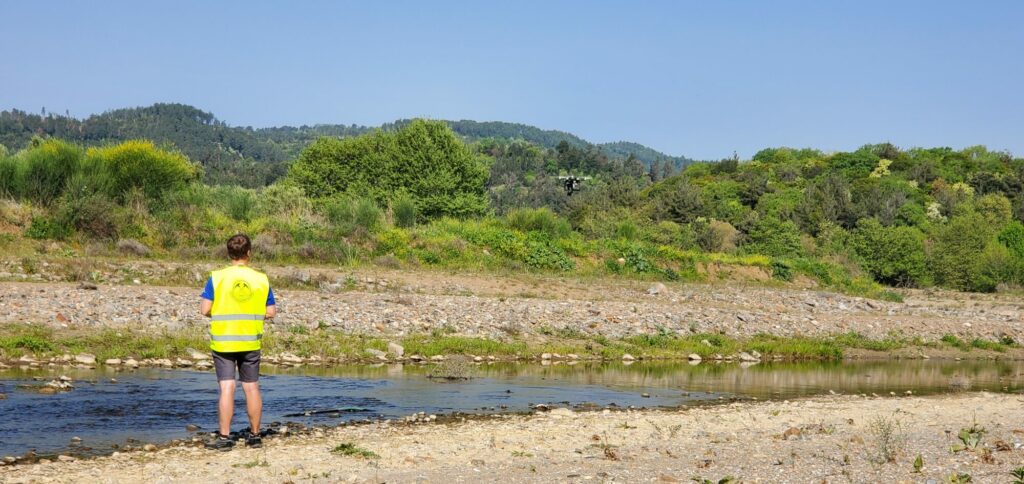Exploring New Frontiers: MultiMiner’s Fieldwork in Chalkidiki
April 2024 marked a significant milestone for the MultiMiner project as our team embarked on a crucial fieldwork mission in the Chalkidiki region. This venture was not only an example of the advancements in modern mining technology, but also a step in our commitment to efficient and environmentally conscious mining practices. Over the course of several days, our team engaged in extensive field activities that included water sampling, drone-based spectral measurements, and dust monitoring. Here, we provide a detailed account of these activities, their significance, and the innovative technologies that set MultiMiner apart.
Water Sampling: Ground Truth for Enhanced Data Analysis
Water sampling is a fundamental aspect of environmental monitoring, particularly in mining regions where water quality can be significantly impacted by mining activities. For MultiMiner, collecting water samples serves as a ground truth mechanism for validating Earth Observation (EO) data analysis. Ground truth data provides the baseline against which EO data, collected via satellite or drones, is compared. This comparison is crucial for ensuring the accuracy and reliability of the machine learning (ML) models developed under the MultiMiner project.
During our fieldwork, partners from BGR, GTK, CGS, and VTT used specialised water sampling bottles to collect samples from various water bodies around the Chalkidiki mine sites. These samples were meticulously collected and transported to the laboratory at the Stratoni mine for comprehensive analysis. The laboratory tests focused on measuring key parameters such as heavy metal concentrations, pH levels, and the presence of solid particles. This thorough analysis not only helps in assessing the current state of water quality but also plays a crucial role in enhancing the predictive capabilities of our ML models.


Drones: Revolutionising Spectral Measurements
In the past, spectral measurements of water bodies were typically conducted using handheld spectrometers or other ground-based equipment. While effective, these methods often lacked the spatial coverage and resolution needed for large-scale environmental monitoring. Today, drones equipped with advanced microspectrometers and multispectral cameras have revolutionised this process, providing a superior alternative to traditional methods.
During our fieldwork in Chalkidiki, the partners utilised the Ocean Optics microspectrometer embedded on a drone to collect water spectra. In parallel, we captured multispectral imaging data using the Parrot Sequoia camera. This dual approach enabled us to create detailed multispectral orthophotomosaics with exceptional spatial resolution. These mosaics are integral to our workflow, as they allow us to scale up the spectral information collected on the ground to broader satellite data such as PlanetScope and Sentinel-2. This capability is crucial for conducting comprehensive multitemporal analysis, which is essential for monitoring environmental changes over time.


Dust Monitoring: Understanding Environmental Impact
Dust monitoring is another critical component of our fieldwork, aimed at assessing the environmental impact of mining activities in Chalkidiki. Dust traps were strategically placed on poles and trees around the mine sites to collect dust samples throughout the dry season. These samples are then analysed to determine their mineral composition and trace element content, providing valuable insights into the levels of dust pollution in the local area.
In addition to dust trap data, we used a VNIR-SWIR spectrometer to obtain spectra of leaves with varying dust loads. This analysis helps us understand how dust affects the spectral properties of the canopy, serving as a proxy for monitoring dust pollution. By combining this information with multitemporal, multispectral, and hyperspectral data sources such as Sentinel-2, EMIT, and PRISMA, we can develop a comprehensive picture of dust pollution levels in Chalkidiki.
The Role of Modern Mining Technology and MultiMiner
What sets MultiMiner apart is its integration of cutting-edge tools and technologies that enhance the efficiency and accuracy of mining operations. Our fieldwork in Chalkidiki is a prime example of this approach in action. We employ novel ML models and a combination of multi-scale and multi-modal EO data to monitor and assess environmental conditions. The use of hyperspectral data from sources like EMIT and PRISMA allows us to perform detailed environmental monitoring across different time scales.
By leveraging these advanced technologies, MultiMiner is able to provide robust and reliable solutions for modern mining challenges. Our commitment to using state-of-the-art tools ensures that we can not only meet the needs of today’s mining industry but also contribute to a more sustainable and environmentally friendly future.
Conclusion: A Commitment to Sustainable Mining
Our fieldwork in Chalkidiki underscores the importance of innovative approaches in tackling the environmental challenges associated with mining. By collecting water samples, utilising drones for spectral measurements, and monitoring dust levels, we are able to gather critical data that informs our understanding of the environmental impact of mining activities. This information is vital for developing effective strategies to mitigate these impacts and promote sustainable mining practices.
As MultiMiner continues to push the boundaries of what is possible in the mining industry, we remain dedicated to our mission of pioneering sustainable solutions that benefit both the environment and the industry. We look forward to sharing more updates and insights from our journey as we work towards a brighter, more conscious future for mining.